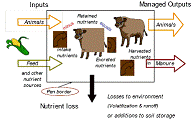Biological Systems Engineering, Department of

Department of Agricultural and Biological Systems Engineering: Presentations and White Papers
Date of this Version
August 2004
Document Type
Article
Abstract
Odor, ammonia and hydrogen sulfide emission data were collected from three phototrophic and three non-phototrophic anaerobic swine lagoons in eastern Nebraska from May 27th to June 18th (late spring) and from July 7th to August 13th (summer). The greatest odor, hydrogen sulfide and ammonia emission rates were from non-phototrophic lagoons during late spring (24.5 OU m-2 s-1, 3.2 μg-H2S m-2 s-1, 34.9 kg NH3-N ha-1 d-1, respectively). Non-phototrophic lagoon odor, ammonia and hydrogen sulfide emission rates were much higher in late spring than summer (24.5 vs. 4.8 OU m-2 s-2, 34.9 vs. 18.0 kg NH3-N ha-1 d-1, 3.2 vs. 0.3 μg-H2S m-2 s-1, respectively). Odor and ammonia emission rates from phototrophic lagoons were relatively constant from late spring to summer (9.4 vs. 4.0 OU m-2 s-1 and 23.0 vs. 16.5 kg NH3-N ha-1 d-1, respectively), but hydrogen sulfide emissions were higher in late spring than summer (1.9 vs. 0.1 μg-H2S m-2 s-1).


Comments
Written for presentation at the 2004 ASAE/CSAE Annual International Meeting, Sponsored by ASAE/CSAE, Fairmont Chateau Laurier, The Westin, Government Centre, Ottawa, Ontario, Canada. 1 - 4 August 2004. Copyright © 2004 J. Byler, D. Schulte, and R. Koelsch.